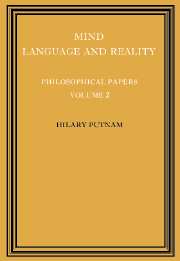Book contents
- Frontmatter
- Contents
- Dedication
- Introduction
- 1 Language and philosophy
- 2 The analytic and the synthetic
- 3 Do true assertions correspond to reality?
- 4 Some issues in the theory of grammar
- 5 The ‘innateness hypothesis’ and explanatory models in linguistics
- 6 How not to talk about meaning
- 7 Review ofThe concept of a person
- 8 Is semantics possible?
- 9 The refutation of conventionalism
- 10 Reply to Gerald Massey
- 11 Explanation and reference
- 12 The meaning of ‘meaning’
- 13 Language and reality
- 14 Philosophy and our mental life
- 15 Dreaming and ‘depth grammar’
- 16 Brains and behavior
- 17 Other minds
- 18 Minds and machines
- 19 Robots: machines or artificially created life?
- 20 The mental life of some machines
- 21 The nature of mental states
- 22 Logical positivism and the philosophy of mind
- Bibliography
- Index
2 - The analytic and the synthetic
Published online by Cambridge University Press: 12 January 2010
- Frontmatter
- Contents
- Dedication
- Introduction
- 1 Language and philosophy
- 2 The analytic and the synthetic
- 3 Do true assertions correspond to reality?
- 4 Some issues in the theory of grammar
- 5 The ‘innateness hypothesis’ and explanatory models in linguistics
- 6 How not to talk about meaning
- 7 Review ofThe concept of a person
- 8 Is semantics possible?
- 9 The refutation of conventionalism
- 10 Reply to Gerald Massey
- 11 Explanation and reference
- 12 The meaning of ‘meaning’
- 13 Language and reality
- 14 Philosophy and our mental life
- 15 Dreaming and ‘depth grammar’
- 16 Brains and behavior
- 17 Other minds
- 18 Minds and machines
- 19 Robots: machines or artificially created life?
- 20 The mental life of some machines
- 21 The nature of mental states
- 22 Logical positivism and the philosophy of mind
- Bibliography
- Index
Summary
The techniques employed by philosophers of physics are usually the very ones being employed by philosophers of a less specialized kind (especially empiricist philosophers) at the time. Thus Mill's philosophy of science largely reflects Hume's associationism; Reichenbach's philosophy of science reflects Viennese positivism with its conventionalism, its tendency to identify (or confuse) meaning and evidence, and its sharp dichotomy between ‘the empirical facts’ and ‘the rules of the language’; and (coming up to the present time) Toulmin's philosophy of science is an attempt to give an account of what scientists do which is consonant with the linguistic philosophy of Wittgenstein. For this reason, errors in general philosophy can have a far-reaching effect on the philosophy of science. The confusion of meaning with evidence is one such error whose effects are well known: it is the contention of the present paper that overworking of the analytic–synthetic distinction is another root of what is most distorted in the writings of conventional philosophers of science.
The present paper is an attempt to give an account of the analytic–synthetic distinction both inside and outside of physical theory. It is hoped that the paper is sufficiently nontechnical to be followed by a reader whose background in science is not extensive; but it has been necessary to consider problems connected with physical science (particularly the definition of ‘kinetic energy’, and the conceptual problems connected with geometry) in order to bring out the features of the analytic–synthetic distinction that seem to me to be the most important.
- Type
- Chapter
- Information
- Philosophical Papers , pp. 33 - 69Publisher: Cambridge University PressPrint publication year: 1975
- 43
- Cited by



